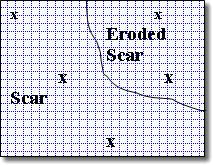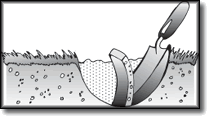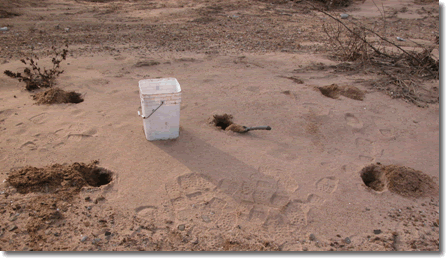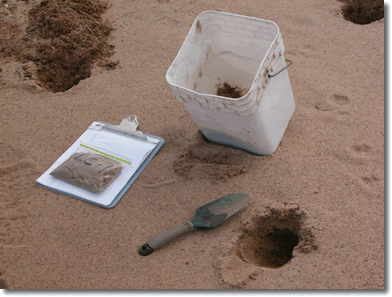Soil Sampling Guide
Surface Soil Sampling for Remediation Surface soil can be easily sampled to determine chemical variation across a scarred area. Care must be taken to collect representative samples and record the samples so that lab results can be used.
Sample Plan:
Examination of the scar will reveal those areas that need to be studied. In the sketch at the right, the scar consists of two areas - an eroded and an un-eroded area. Those two areas should be sampled individually as they are large enough to warrant several sample locations. Keep in mind that soil sampling needs to be done when the surface soil is dry. Surface soil should be sampled to till depth, about 6". Soil is quite variable even across a small area--an acre or less in size. For this reason composite samples are to be preferred over single spot samples. |
 |
Sampling Process:
Composite samples are made up of soil collected around a single location as described below. Soil should be collected with a clean spade or trowel. Debris should be cleared from the surface and a hole dug to six inches. Note that in some places soil is less than six inches thick on top of bedrock. In those cases, sample the soil as deeply as possible. Once the hole is dug, scoop a slice of soil off one side of the hole and place the slice into a clean bucket. |
 |
| Repeat these two steps for five separate slices from a single sample location point in an area approximately six feet square as shown in the photo. Mix the soil in the bucket while removing sticks, rocks, and other debris. |
 |
|
After mixing, remove approximately 8 oz. of the soil material and place it into a clean zip-lock or similar bag that can be securely sealed. Label the bag with a sample number that corresponds to the number on the scar sketch.
Collect approximately five composite samples for each acre of scar.
|
 |
Shipping: Collect together the labeled composite samples and place them in a box or shipping container together with a list of the samples and your name and address. This needs to be delivered to the soil lab of your choice by several means.
- Samples can be shipped or mailed to a commercial lab.
- Samples can be mailed to the KSU Soil Lab, 2308 Throckmorton Hall, Manhattan, KS 66506 or processed through your local County Extension Office
In all cases be sure to request that analyses of soils by the laboratory include at a minimum the following: Electrical Conductivity (EC), Cation Exchange Capacity (CEC), and Exchangeable Sodium Percentage (ESP). It is also recommended to inquire about the cost of laboratory analyses prior to sending samples.




